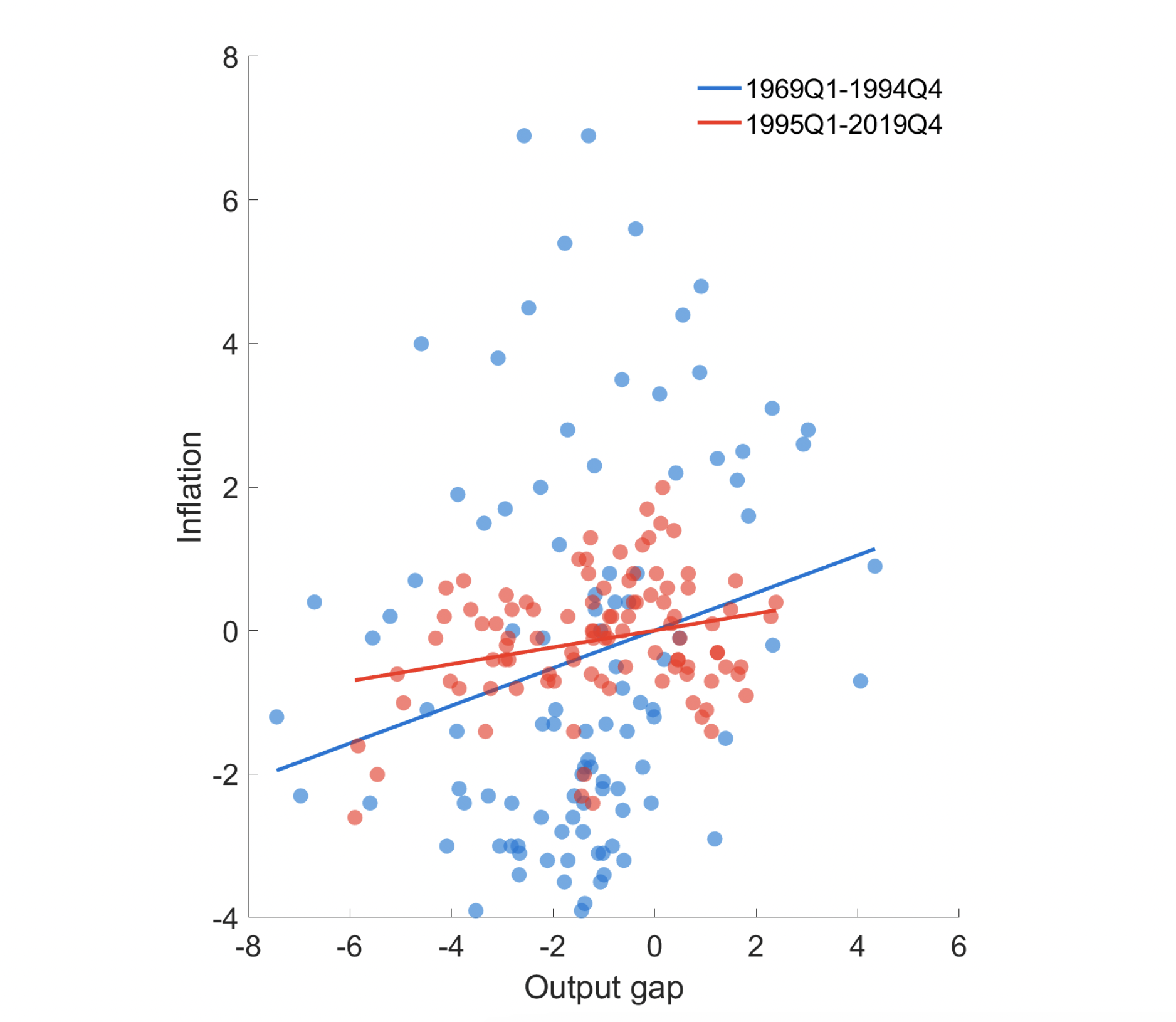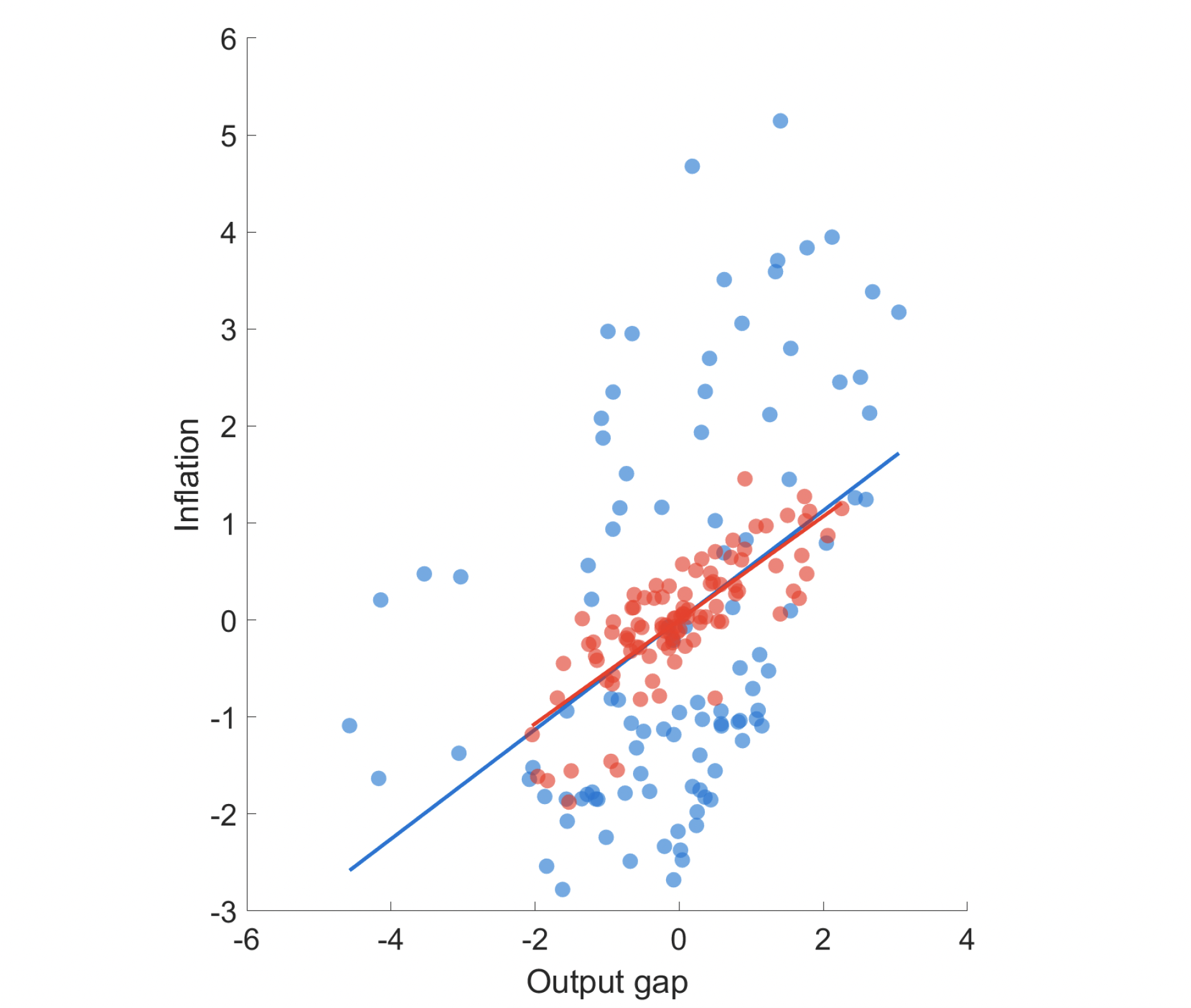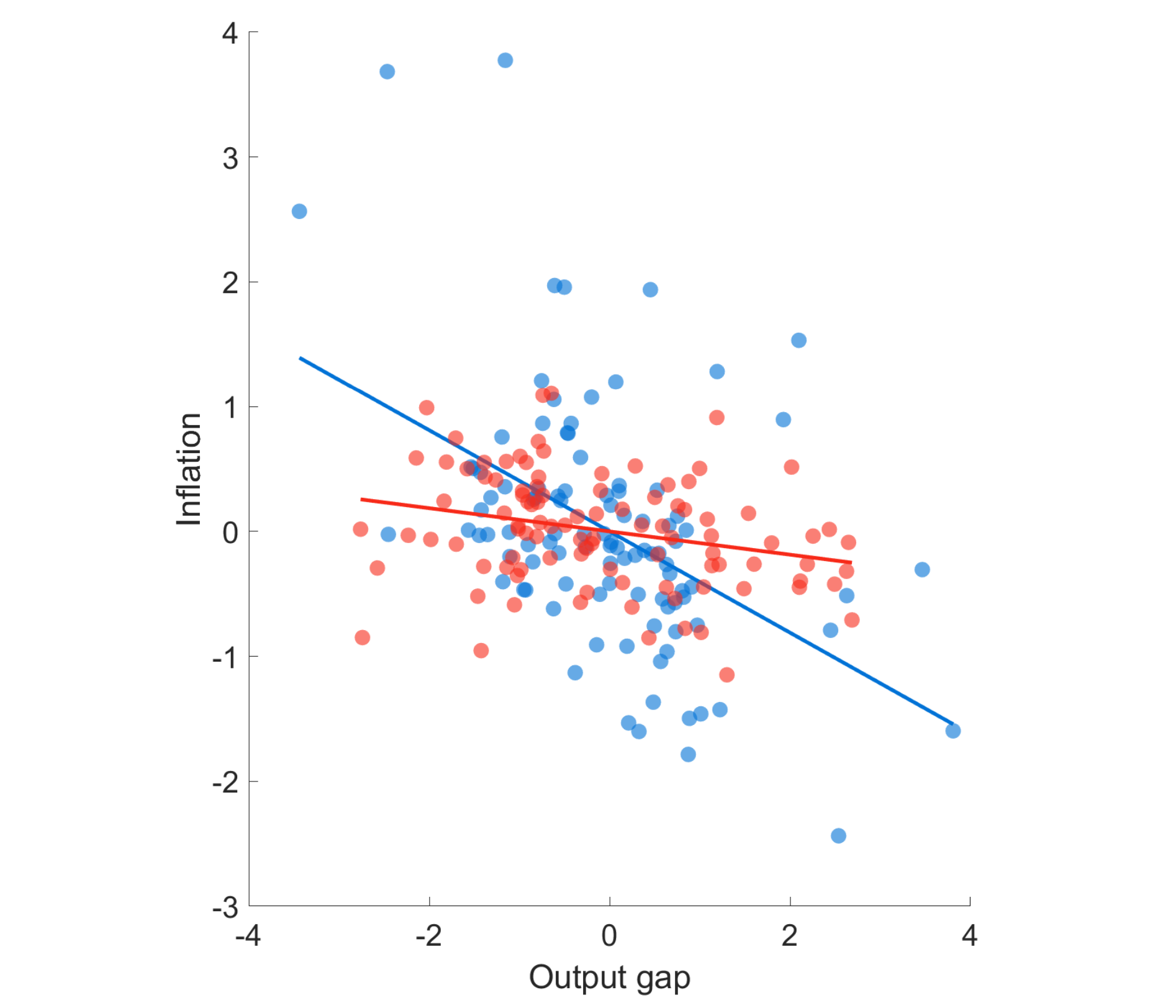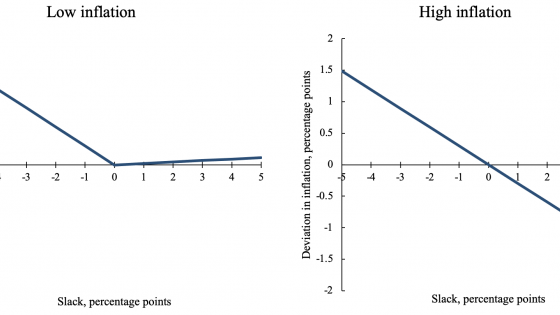Price inflation has remained remarkably stable in the US since the mid-1990s. While a new regime may arise in the aftermath of COVID, the last few decades have delivered a major decline in inflation volatility without comparable reductions in the volatility of economic activity. During the pre-Great Recession boom, inflation (measured with the GDP deflator) was stubbornly stable, barely above 2%. During the Great Recession, in the face of the largest drop in economic activity since the Great Depression, inflation declined by only around 3%. In the aftermath of the Great Recession, real economic activity recovered (albeit slowly), and unemployment reached a 50-year low slightly below 4%. Yet, inflation remained consistently below 2%.
Why did inflation become so stable, and why did it disconnect from real economic activity? At least three different explanations are proposed in the literature. The first, and perhaps most widespread, narrative points to a decline in the slope of the Phillips curve – a structural equation describing how pressure in the economy translates into inflation (e.g Stock and Watson 2020). Possible reasons for such a flattening include a more prominent role for global factors (such as increased import competition), rising market concentration, and changes in the network structure of the US production sector.
A second explanation highlights the role of monetary policy: the Federal Reserve may have become more aggressive over time with respect to achieving its inflation stability mandate (McLeay and Tenreyro 2018). Proponents of this view acknowledge that the Phillips curve could be alive and stable, and instead argue that stricter inflation targeting has led to smaller footprints associated with demand factors. This policy change may have resulted in reduced inflation volatility.
The third explanation concerns a potential change in the composition of shocks over time (e.g. Hobiin 2020). Supply shocks, in particular, may have become relatively more prominent or more concentrated in specific periods, as was the case for oil shocks in the aftermath of the Great Recession (Coibion and Gorodnichenko 2015). If this is the case, then inflation may co-move less with real economic activity even if both the Phillips curve slope and the stance of monetary policy remain stable. We refer to the three explanations summarised above as the slope hypothesis, the policy hypothesis, and the shock hypothesis.
In a recent paper (Bergholt et al. 2023), we evaluate the empirical relevance of these hypotheses by confronting mainstream New Keynesian theory with US macro data. As a first step, we use a canonical New Keynesian model to derive some simple arithmetics that may inform us about the observed disconnect between inflation and economic activity. Since that model features nominal rigidities, it can be summarised in the output gap–inflation space by an upward-sloping supply curve (the Phillips curve) and a downward-sloping demand curve (the investment–savings curve). The supply curve is upward-sloping because increased demand creates resource scarcity and motivates firms to raise prices. The demand curve is downward-sloping because the central bank responds to inflation by hiking its policy rate, causing a decline in aggregate demand for goods and services.
Now, consider an econometrician who lives in the world just described and would like to regress inflation on the output gap in order to learn about an observed inflation disconnect. We inspect the properties of structural supply and demand curves, and formally derive the following testable implications that the econometrician may confront with data. First, the slope hypothesis, by proposing a flattening of aggregate supply while the curvature of demand remains fixed, is the only one that implies a less positive regression slope when data are purged for supply-side shocks. The policy hypothesis, in contrast, proposing a flattening of aggregate demand while the curvature of supply remains fixed, is unique in that it implies a less negative regression slope when data are purged for demand-side shocks. Intuitively, stricter central bank commitment to inflation stability translates into smaller inflation movements and a flatter demand curve. Finally, the shock hypothesis is the only narrative that implies stable regression slopes when we condition either demand shocks or supply shocks. This hypothesis advocates changes in the cocktail of realised shocks rather than in the responsiveness of supply and demand to a given disturbance. Combined, our simple arithmetics give rise to a set of testable hypotheses which enable us to disentangle the competing explanations. All that is needed is a way to purge demand from supply in the observable, unconditional data.
This brings us to the second step, which is to empirically identify exogenous shifts in demand and supply in order to confront the arithmetics just described with actual data. To this end, we estimate a structural vector autoregression (SVAR) model on two adjacent sample periods (1969:Q1-1994:Q4 and 1995:Q1-2019:Q4). We use US macro data on the GDP deflator and the output gap as computed by the Congressional Budget Office (CBO). Importantly, our observed output gap is measured in deviation from some notion of a slow-moving trend, not in deviation from a hypothetical equilibrium with flexible prices, thus implying that all supply-side shocks (not only cost-push or markup shocks) shift the supply curve and must be accounted for. Thus, our empirical model is relatively general and imposes only a minimal set of sign restrictions to disentangle demand shocks from supply shocks. With the two shocks identified, one can estimate the slopes of aggregate demand and supply (each corresponds to a regression line fitting a cloud of data points generated by one of the identified shocks), and check to what extent these two conditional slopes have changed over time. This is exactly what we do.
Figure 1a Unconditional data
Figure 1b Conditional on demand
Figure 1c Conditional on supply
Figure 1a illustrates a major decline in the slope coefficient estimated on unconditional data. Quantitatively, the estimated slope is 0.26 during the sample period 1969:Q1-1994:Q4, but only 0.12 during the period 1995:Q1-2019:Q4. Thus, we observe a decline of more than 50% in the unconditional slope in the second sample. At first glance, one may reach the conclusion that the weakened relationship comes about from a flatter, structural Phillips curve.
Figure 1b plots the relationship between the output gap and inflation when we condition on the empirical variation attributed solely to identified demand shocks. The slope conditional on demand features only a minor decline across samples, from 0.56 to 0.53. Thus, the empirical relationship between output and inflation, which has weakened substantially in unconditional data, remains almost unchanged once we purge out supply-side variation in the data. In this sense, we do not find statistical evidence of a flattening of the Phillips curve. Rather, the Phillips curve seems to be alive and well.
Finally, Figure 1c shows the results when we condition only on identified supply shocks. Naturally, once we consider supply-side variation only, the relationship between output and inflation turns negative. However, we find large differences in the conditional slopes across samples. In fact, the slope goes from -0.41 to -0.09. The null hypothesis of no change in the demand slope across samples is rejected at any relevant significance level. It is clear that our estimated demand curve slope changes from highly negative to relatively flat.
All in all, we conclude that there seems to be a significant flattening of the slope conditional on supply shocks, and this flattening is substantially larger than what we find conditional on demand shocks. Thus, the evidence reported here points to a flattening of the demand curve rather than the supply curve. We believe the most natural interpretation for such a flattening is a more aggressive Fed response to inflation fluctuations, in keeping with the estimates presented in the seminal paper by Clarida et al. (2000). This view is supported by estimated variance decompositions, as shown in the paper.
Our sample stops in 2019:Q4, just before the COVID recession. Since then, inflation has come back, and the current debate is once again on how policy should be set in order to lower inflation, and not to stimulate it as in the previous decade (see di Giovanni et al. 2023, Leigh, Mishra and Ball 2022, Cramer et al. 2022, and Romei and Fornaro 2022 for recent analysis on the inflation boom). There are two reasons why our results remain topical. First, the COVID recession has re-confirmed the importance of supply-side factors for output and inflation dynamics. Disruptions in global supply chains, shocks to energy prices and labour supply factors (the Great Resignation and the substantial drop in immigration represent two leading examples) are routinely mentioned as important drivers of the macroeconomy. Therefore, we would argue that the recent experience strengthens our argument that it is important to control for all supply shocks in the empirical analysis of the Phillips curve.
Second, our simple arithmetics are potentially useful also in the current phase. Inflation is again well above the Federal Reserve's target and, if this tendency continues, we could have entered into a new regime more similar to our first sample. A higher slope of the Phillips curve (perhaps reflecting some form of de-globalisation) or a less aggressive response of monetary policy are compatible with the resurgence of inflation (in addition, of course, with variations in the volatilities of the underlying disturbances). While it is still too early to draw conclusions about the main mechanisms driving recent data, we believe that our simple arithmetics may help to organise the discussions currently at play.
Authors’ note: The views expressed in this column are those of the authors and should not be attributed to Norges Bank or to the International Monetary Fund.
References
Bergholt, D, F Furlanetto, and E Vaccaro-Grange (2023), “Did monetary policy kill the Phillips curve? Some simple arithmetics”, Norges Bank Working Paper 2/2023.
Clarida, R, J Galí, and M Gertler (2000), “Monetary policy rules and macroeconomic stability: Evidence and some theory”, The Quarterly Journal of Economics 115(1): 147–180.
Cramer, J, Summers, L, and M Bolhuis (2022), “Past and present inflation are more similar than what you think”, VoxEU.org, 22 June.
Coibion, O and Y Gorodnichenko (2015), “Is the Phillips curve alive and well after all? Inflation expectations and the missing disinflation”, American Economic Journal: Macroeconomics 7(1): 197–232.
Di Giovanni, J, S Kalemli-Ozcan, A Silva and M Yildirim (2023), “Supply chains, trade and inflation”, VoxEU.org, 7 January.
Hobijn, B (2020), “The supply-side origins of US inflation”, in G Castex, J Galí and D Saravia (eds), Changing Inflation Dynamics, Evolving Monetary Policy, Banco Central de Chile.
Leigh, D, Mishra, P, and L Ball (2022), “Understanding US inflation in the COVID era”, VoxEU.org, 22 November.
McLeay, M and S Tenreyro (2018), “Optimal inflation and the identification of the Phillips curve”, VoxEU.org, 3 July.
Romei, F, and L Fornaro (2022), “Understanding the global rise in inflation”, VoxEU.org, 27 May.
Stock, J H and M W Watson (2020), “Slack and cyclically sensitive inflation”, Journal of Money, Credit and Banking 52(S2): 393–428.








